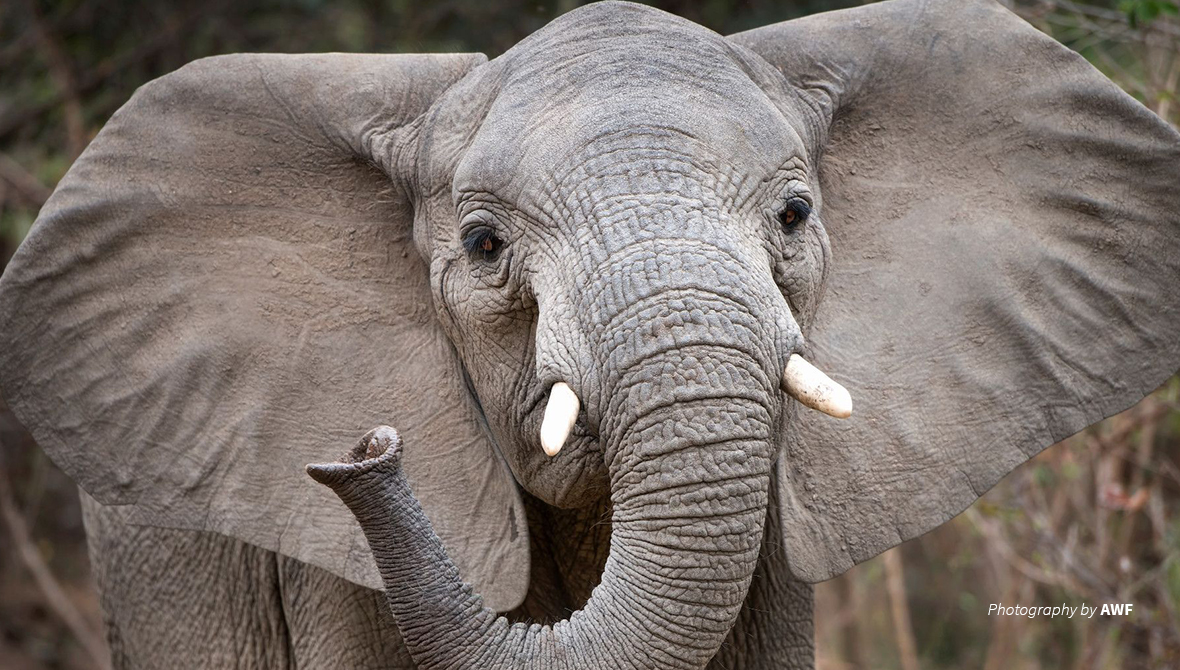Understanding and safeguarding Africa’s most iconic species – the elephant

As African Wildlife Foundation celebrates our 60th anniversary, we are sharing stories that honor our past, celebrate the present, and look forward to the future
Much of what we know of elephants today — behaviors that suggest a rich emotional life, lifelong ties among family members, sophisticated communications, high intelligence, and so much more — is due to the groundbreaking field research of Cynthia Moss and the Amboseli Elephant Research Project she founded.
AWF supported Moss’s Amboseli project from its beginning in the 1970s. The New York-raised Moss had about a year’s worth of experience studying elephants — she’d been an assistant to zoologist Iain Douglas-Hamilton, who photographed and studied elephants in Lake Manyara National Park. Now, she was looking to do her own research. Someone suggested she find a way to study the elephants of Kenya’s Amboseli park. These “ellies” seemed to be freer in their behavior, as they were less under the threat of poachers due to the presence of Maasai people, tourists, and researchers. She and fellow researcher Harvey Croze began a part-time study in 1972.
A former Newsweek reporter and a gifted writer and editor, Moss worked as editor of AWF’s monthly newsletter, Wildlife News, and in 1975 published a well-received survey of East African mammals, Portraits in the Wild. With her credentials as a scientist bolstered by the book, AWF in 1975 gave Moss a grant to conduct field research full-time. (Croze had left the research the previous year.) Moss was using a little Renault as her off-road vehicle, so in 1976, AWF handed over to Moss a used Land Rover as well.
The Amboseli Elephant Project would become one of the longest-running studies of wildlife behavior and ecology and the longest elephant study. It has gathered data on the life histories of more than 2,000 elephants, altering and enriching our understanding of elephant life. Moss also has helped raise awareness of the plight of elephants through award-winning books and documentaries such as An Apology to Elephants and Echo: An Elephant to Remember.
> Are elephants evolving to lose their tusks? Learn more
In 2001, when Moss won a MacArthur Fellowship, she said she was "forever indebted to the support I have received from the African Wildlife Foundation. That support has been more than just financial; it has been a statement of faith in me throughout the years...both the Washington office and the Nairobi field office have backed me up logistically and administratively, providing a firm base for the project since its onset."
With its many research branches, the Amboseli project also helped serve AWF’s mission of training and education. In addition to training park managers from around Africa in elephant-observation techniques, we also supported the careers of individual researchers. In 1990, Kadzo Kangwana, a Kenyan zoologist, joined the project with support from AWF, focusing on the evolution and influence of Maasai culture, land use, and attitudes in relationship to elephant conservation.
In 1991, Hamisi Mutinda, a University of Nairobi graduate student, began a study of reproductive hormone cycles in female elephants. Sponsored by the Kenya Wildlife Service (KWS) with field support from AWF, he collected urine from female elephants in various reproductive states. The study was the first to assess contraception as a potential elephant management technique, considered by many scientists at the time as a possible solution to human-elephant conflicts.
The Amboseli work also benefited from the research of Norah Wamaitha and Soila Salyielel, who had started service as assistants to Moss in 1986. Together they conducted in-depth monitoring of the elephants, knowing their whereabouts, condition, and habitat use. In time, like Moss, they knew and could name every elephant in the park.
After the Amboseli project became independent of AWF, around the year 2000, AWF researcher Alfred Kikoti documented the demographic characteristics and movements of elephants on the Tanzanian side of the transboundary Kilimanjaro Heartland. His research helped to fill a gap in knowledge about the travel and behavior of Amboseli elephants outside the park.